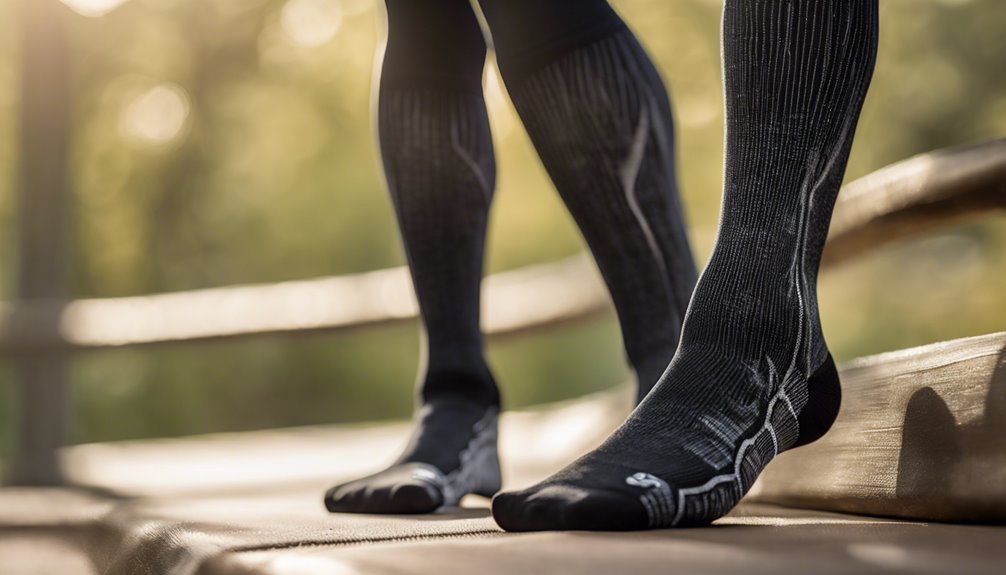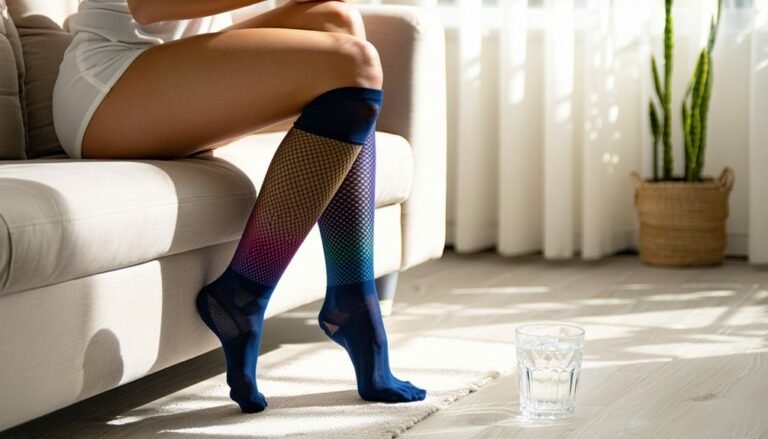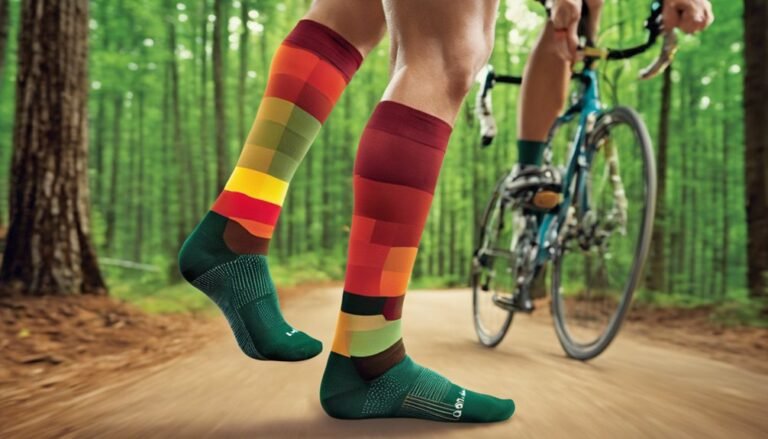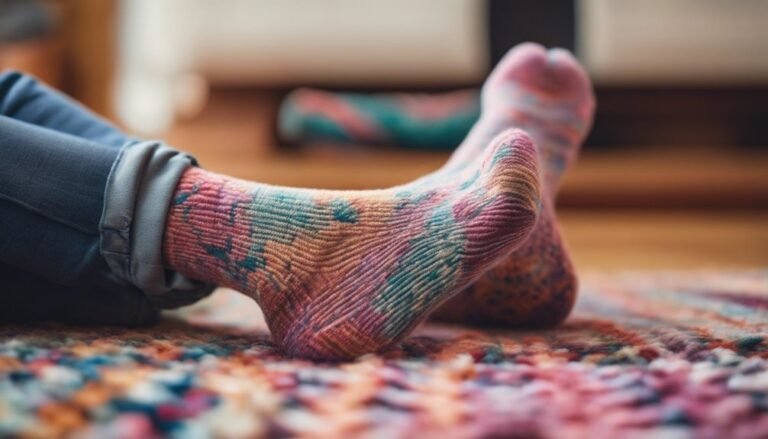How Compression Socks Improve Circulation & Prevent Swelling
Imagine you're on a long flight, your legs cramped and uncomfortable from sitting still for hours. Could there be a solution to prevent swelling and enhance blood flow during such situations?
Compression socks provide exactly that remedy. By applying graduated pressure to your legs and feet, compression socks effectively enhance venous return, promoting efficient blood flow back to the heart.
The maximum pressure at the ankle gradually decreases up the leg, minimizing fluid buildup and reducing discomfort from prolonged sitting or standing. These benefits not only improve overall well-being but also help you perform better during activities.
Discover more about the types and best practices for using compression socks effectively.
What Are Compression Socks?

Compression socks are specialized garments designed to apply pressure to your legs and feet, promoting better blood circulation. They come in various compression sock types, ranging from knee-high to thigh-high options, each catering to different needs. You'll find graduated compression socks, which offer varying levels of pressure, ideal for enhancing venous return. Materials used in compression socks include nylon, spandex, and cotton, ensuring durability and comfort. Choosing the right compression sock materials impacts breathability and moisture-wicking properties, essential for extended wear. Whether you're an athlete, traveling, or managing a medical condition, understanding these sock types and materials can empower you to select the best option for your lifestyle, ultimately enhancing your freedom of movement and overall well-being.
How Compression Socks Work
When you're wearing compression socks, they work by exerting graduated pressure on your legs, which helps improve blood flow and reduce swelling. This compression technology applies the most pressure at the ankle, gradually decreasing up the leg. This design encourages venous return, helping blood flow back to the heart more efficiently. As a result, your legs feel lighter and less fatigued, combating the heaviness often associated with prolonged sitting or standing. By enhancing circulation, compression socks can also prevent the buildup of fluids, which contributes to swelling. Whether you're at work, traveling, or exercising, these socks provide the support you need for peak leg health and freedom of movement, making them an essential addition to your daily routine.
The Science of Compression Therapy
While many may not realize it, the science behind compression therapy is rooted in principles of biomechanics and physiology. Compression socks apply graduated pressure, which enhances blood flow in your legs. This is particularly beneficial for individuals with venous insufficiency, where blood doesn't efficiently return to the heart. The pressure exerted by the socks helps to reduce the diameter of distended veins, improving venous return and preventing blood pooling. By supporting the vascular system, compression therapy facilitates oxygen delivery to tissues and aids in the removal of metabolic waste. This mechanism not only enhances circulation but also plays an essential role in reducing swelling, ensuring that your legs feel more energized and less fatigued throughout the day.
Benefits of Improved Circulation
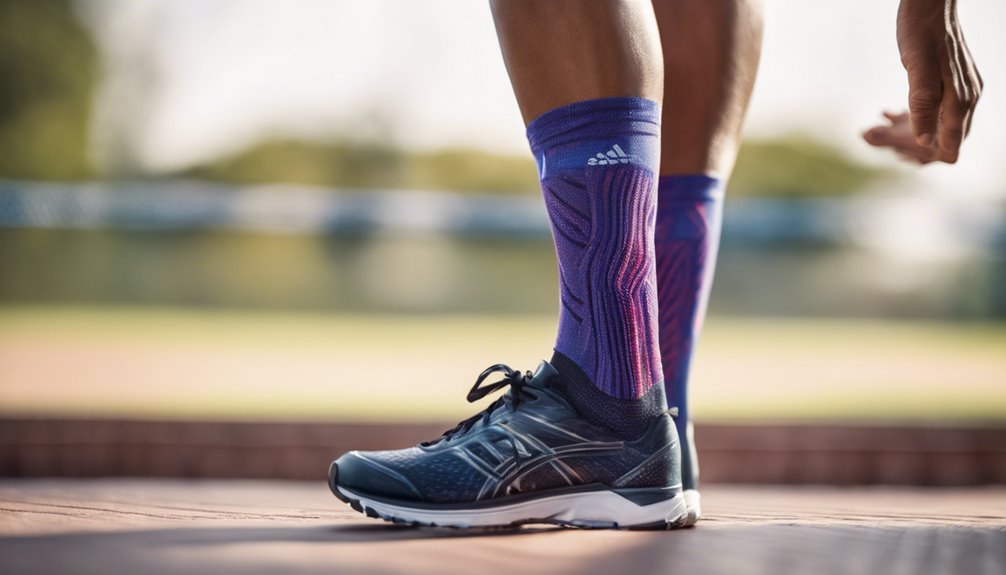
Improved circulation offers numerous benefits that extend beyond mere comfort, greatly impacting overall health and well-being. When blood flows more efficiently, your body receives essential nutrients and oxygen more effectively, promoting cellular health. This circulation improvement can enhance energy levels, making you feel more vibrant and ready to take on daily tasks. Additionally, better circulation supports faster recovery from physical activity, reducing fatigue and muscle soreness. You may also notice improved cognitive function, as your brain benefits from increased blood flow, sharpening your focus and mental clarity. Moreover, these health benefits contribute to a lower risk of chronic conditions, such as varicose veins or deep vein thrombosis, empowering you to maintain a more active and fulfilling lifestyle.
Reducing Swelling With Compression Socks
Enhanced circulation not only boosts energy and cognitive function but also plays an essential role in reducing swelling, a common issue for many individuals. Compression socks provide targeted pressure, which enhances blood flow and promotes fluid movement away from the extremities. This swelling reduction is vital, especially for those who spend long hours standing or sitting. By applying consistent pressure, these socks help prevent fluid accumulation, delivering noteworthy compression benefits. You'll find that wearing them during travel, exercise, or daily activities can greatly alleviate discomfort and enhance your overall well-being. Ultimately, incorporating compression socks into your routine can be a simple yet effective way to combat swelling, allowing you to enjoy greater freedom of movement and comfort throughout your day.
Who Can Benefit From Compression Socks?
Compression socks can benefit a variety of individuals, including athletes, pregnant women, and frequent travelers. If you're active or spend long hours on your feet, these socks can improve circulation and reduce discomfort. Understanding who can gain the most from compression therapy is essential for maximizing its effectiveness.
Athletes and Active Individuals
Although you might not realize it, athletes and active individuals can greatly benefit from wearing compression socks during workouts and recovery. These specialized garments offer essential support for performance enhancement and recovery support.
Here's how they help:
- Improved blood circulation: Promotes oxygen delivery to muscles.
- Reduced muscle fatigue: Fights soreness during and after physical activity.
- Enhanced recovery: Speeds up healing and reduces downtime.
- Injury prevention: Stabilizes muscles and joints to minimize risk.
Incorporating compression socks into your routine can release your potential, allowing you to push your limits while minimizing the impact on your body. Whether you're running, cycling, or hitting the gym, these socks are a game-changer for your athletic journey.
Pregnant Women
During pregnancy, many women experience swelling in their legs and feet due to increased blood volume and hormonal changes. This can lead to significant pregnancy discomfort. Compression socks can help alleviate these issues by promoting better blood circulation. They provide graduated pressure, which encourages blood flow back to the heart and reduces fluid retention in the lower extremities. As your body goes through various changes, wearing compression socks can make a noticeable difference in how you feel. They not only improve comfort but also lower the risk of developing more serious conditions, such as varicose veins. By incorporating compression socks into your routine, you can enjoy your pregnancy with less discomfort and more freedom to move.
Travelers and Commuters
When you're traveling or commuting for long periods, your legs can become fatigued and swollen due to prolonged sitting. Compression socks are essential for anyone facing these challenges, especially during long flights or daily commutes. They promote better circulation and help reduce discomfort, allowing you to enjoy your journey more freely.
- Prevent swelling in your legs
- Enhance blood flow during extended travel
- Reduce the risk of blood clots
- Keep your legs feeling energized
Types of Compression Socks Available

There are several types of compression socks available, each designed to meet specific needs and conditions. You'll find graduated compression socks, which apply varying pressure to enhance blood flow, ideal for those with circulation issues. Ankle-length options are perfect for everyday wear, while knee-high socks offer greater support for active lifestyles. If you're looking for something unique, custom designs allow you to tailor compression levels and styles to fit your preferences. Plus, there are fashion options that combine aesthetics with functionality, enabling you to express your style while reaping the benefits of compression therapy. Whether for travel, work, or leisure, selecting the right type can considerably impact your comfort and health.
How to Choose the Right Compression Socks
Choosing the right compression socks involves understanding sock compression levels, ensuring a proper fit, and considering material and breathability. You need to assess your specific needs based on activity level and health conditions. By focusing on these key factors, you'll find the best option for ideal circulation support.
Sock Compression Levels
Understanding sock compression levels is essential for selecting the right compression socks tailored to your needs. Different levels cater to various conditions and activities. Here's a quick guide:
- Mild compression (8-15 mmHg): Great for everyday wear; helps with minor swelling and fatigue.
- Moderate compression (15-20 mmHg): Ideal for those who sit or stand for long periods; it aids circulation and reduces swelling.
- Firm compression (20-30 mmHg): Recommended for managing varicose veins or post-surgery recovery; provides significant support.
- Extra firm compression (30-40 mmHg): Typically used for serious medical conditions; consult a healthcare professional before use.
Proper Fit Techniques
Finding the right fit for compression socks is essential for maximizing their benefits. Start by taking accurate fit measurements of your legs, focusing on the ankle, calf, and thigh circumference, as well as the length from heel to knee. These measurements will guide your size selection. Most brands offer size charts that correlate your measurements to specific sock sizes. Remember, a proper fit should provide support without being overly restrictive. When trying on the socks, verify they feel snug yet comfortable, with no pinching or bunching. If you experience any discomfort, reevaluate your fit measurement and consider trying a different size. Choosing the right fit ultimately enhances circulation and prevents swelling, allowing you to enjoy greater freedom in your daily activities.
Material and Breathability
While selecting compression socks, the material and breathability play crucial roles in your overall comfort and effectiveness. The right fabric types can enhance both support and moisture management, making certain your feet stay dry and comfortable throughout the day.
Consider these factors:
- Nylon and Spandex: Offers elasticity and durability.
- Cotton Blends: Provides breathability but may retain moisture.
- Moisture-Wicking Fabrics: Helps keep your feet dry by pulling sweat away.
- Compression Levels: Make sure the material maintains compression without compromising airflow.
Choosing socks with the right fabric types not only boosts circulation but also minimizes swelling. Prioritize breathability to enjoy the freedom of movement and comfort you deserve, whether you're at work, exercising, or relaxing.
Wearing Compression Socks: Tips and Guidelines
When you're ready to wear compression socks, it's important to follow some key guidelines to maximize their benefits. First, choose the right size; improperly fitting socks can hinder circulation instead of improving it. It's recommended to wear them during activities that require prolonged standing or sitting, typically for 8-12 hours, depending on your needs. For peak sock care, hand wash them in cold water and air dry to maintain elasticity. Avoid wearing them while sleeping unless advised by a healthcare professional. If you experience discomfort or increased swelling, reevaluate the wearing duration. Always consult with a healthcare provider for personalized recommendations based on your health status and lifestyle to guarantee you get the most out of your compression socks.
Potential Risks and Considerations
Wearing compression socks can greatly improve circulation, but there are potential risks and considerations to keep in mind. It's important to consult with a healthcare professional before using them, as improper use may lead to complications.
- Compression risks: Excessive pressure can restrict blood flow rather than enhance it.
- Allergic reactions: Some materials may cause skin irritations or allergies.
- Contraindications considerations: Conditions like peripheral artery disease may make wearing them unsafe.
- Medical advice: Always seek guidance from a doctor to guarantee proper fit and usage.
Being aware of these factors can help you enjoy the benefits of compression socks while avoiding unwanted complications. Prioritize your health and make informed choices!
Frequently Asked Questions
Can I Wear Compression Socks While Sleeping?
You can wear compression socks while sleeping. They can provide sleeping benefits by improving circulation effects during rest. However, it's best to consult a healthcare professional to guarantee it's suitable for your specific needs.
How Long Should I Wear Compression Socks Each Day?
Ever wondered how long you should wear compression socks daily? For ideal usage, aim for 8 to 12 hours each day. This duration helps guarantee you reap the benefits without feeling restricted or uncomfortable.
Are There Specific Brands Recommended for Quality Compression Socks?
When considering brand comparisons for compression socks, look for those made with high-quality materials like nylon and spandex. Brands such as Sigvaris and CEP are often recommended for their durability and effective compression levels.
Can Compression Socks Help With Sports Performance and Recovery?
Yes, compression socks can enhance athletic recovery by improving blood flow and reducing muscle vibration. These compression benefits help minimize soreness and fatigue, allowing you to perform better and recover faster after intense workouts or competitions.
Are There Any Age Restrictions for Wearing Compression Socks?
Age's just a number when it comes to compression socks! There aren't strict age restrictions; however, understanding compression sock benefits and debunking compression sock myths is essential for safe and effective use across all ages.

